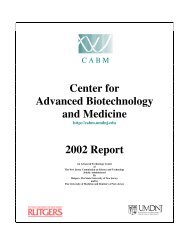Annual Report 2011 - Center for Advanced Biotechnology and ...
Annual Report 2011 - Center for Advanced Biotechnology and ...
Annual Report 2011 - Center for Advanced Biotechnology and ...
You also want an ePaper? Increase the reach of your titles
YUMPU automatically turns print PDFs into web optimized ePapers that Google loves.
DNA-binding domain of AgrA, establishing a novel fold <strong>for</strong> the LytTR domain that<br />
regulates virulence factor expression in many pathogenic bacteria. Recent studies<br />
have focused on purification <strong>and</strong> characterization of full-length AgrA with an<br />
emphasis on underst<strong>and</strong>ing the role of the extreme C terminus that is altered by a<br />
phase-variation mechanism, inactivating AgrA at late stages of infection.<br />
WATERGATE LOGSY NMR experiments were used to identify drug-like fragments<br />
that bind to AgrA. All six lig<strong>and</strong>s identified bind to the same site, overlapping the<br />
surface required <strong>for</strong> binding. Three of the fragments have been shown to inhibit DNA<br />
binding <strong>and</strong> are being pursued <strong>for</strong> inhibitor development. The Stock laboratory has<br />
determined the structures of both inactive <strong>and</strong> activated full-length VraR, a<br />
vancomycin-resistance-associated regulator that plays a central role in maintaining<br />
the integrity of the cell wall peptidoglycan <strong>and</strong> in coordinating responses to cell wall<br />
damage. These structures represent the first inactive <strong>and</strong> active pair of full-length<br />
response regulator transcription factors. The structures establish the mechanism of<br />
activation of VraR via dimerization <strong>and</strong> reveal an unusual deep binding pocket with<br />
great potential <strong>for</strong> inhibitor development. Virtual docking analyses using the Zinc<br />
database of available compounds have identified many compounds predicted to bind<br />
to this pocket. In collaboration with Ed LaVoie (School of Pharmacy, Rutgers<br />
University) <strong>and</strong> John Kerrigan (CINJ), these compounds have been ranked <strong>and</strong> several<br />
have been selected as a starting point <strong>for</strong> inhibitor development.<br />
Dimer interface of active VraR<br />
receiver domain. The protruding<br />
Methionine 13 from one monomer<br />
fits into a deep binding cleft of the<br />
other monomer, a site that is<br />
being targeted <strong>for</strong> development of<br />
inhibitors as leads <strong>for</strong><br />
development of novel antibiotics.<br />
66



